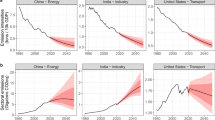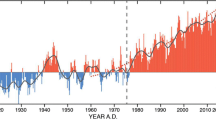Abstract
Analysis of the DICE model indicates that it contains unsupported assumptions, simple extrapolations, and misspecifications that cause it to understate the rate at which economic activity emits greenhouse gases and the rate at which the atmosphere retains greenhouse gases. The model assumes a world population that is 2 billion people lower than the ’base case' projected by demographers. The model extrapolates a decline in the quantity of greenhouse gases emitted per unit of economic activity that is possible only if there is a structural break in the economic and engineering factors that have determined this ratio over the last century. The model uses a single equation to simulate the rate at which greenhouse gases accumulate in the atmosphere. The forecast for the airborne fraction generated by this equation contradicts forecasts generated by models that represent the physical and chemical processes which determine the movement of carbon from the atmosphere to the ocean. When these unsupported assumptions, simple extrapolations, and misspecifications are remedied with simple fixes, the economic impact of global climate change increases several fold. Similarly, these remedies increase the impact of uncertainty on estimates for the economic impact of global climate change. Together, these results indicate that considerable scientific and economic research is needed before the threat of climate change can be dismissed with any degree of certainty.
Similar content being viewed by others
References
Adams, F. G. and Miovic, P.: 1968, 'On Relative Fuel Efficiency and the Output Elasticity of Energy Consumption in Western Europe’, J. Industr. Econ. 17, 41–56.
Berndt, E. R.: 1978, 'Aggregate Energy, Efficiency, and Productivity Measurement’, Annual Review of Energy 3, 225–273.
Bolin, B.: 1986, 'How Much CO2 Will Remain in the Atmosphere?’, in Bolin, B., Doos, B., Jager, and Warisk, R. (eds.), The Greenhouse Effect, Climate Change, and Ecosystems, John Wiley and Sons, Chichester, England.
Bolin, B., Bjorkstrom, A., Holmen, K., and Moore, B.: 1983, 'The Simultaneous Use of Tracers for Ocean Circulation Studies’, Tellus 35B, 206–236.
Bos, E., Vu, M. T., Levin, A., and Bulatao, R. A.: 1990, World Population Projections 1989–1990 Edition: Estimates and Projections with Related Demographic Statistics, Johns Hopkins University Press, Baltimore and London.
Bos, E., Vu, M. T., Levin, A., and Bulatao, R. A.: 1993, World Population Projections 1992–1993 Edition: Estimates and Projections with Related Demographic Statistics, Johns Hopkins University Press, Baltimore and London.
Chapman, D., Suri, V., and Hall, S. G.: 1995, 'Rolling DICE for the Future of the Planet’, Contemporary Economic Policy 13 (July), 1–9.
Cleveland, Costanza, C. R., Hall, C. A. S., Kaufmann, R.: 1984, 'Energy and the United States Economy: A Biophysical Perspective’, Science 225 890–897.
Dowlatabadi, H. and Morgan, M. G.: 1993, 'Integrated Assessment of Climate Change’, Science 259, 1813.
Gaskins, D. and Weyant, J.: In press, Controlling Global Carbon Emissions: Costs and Policy Options, Stanford University Press.
Ellington, R. T. and Meo, M.: 1991, 'Calculating the Net Greenhouse Warming Effect of Renewable Energy Resources: Methanol from Biomass’, J. Environmental Systems 20(4), 287–301.
Kaufmann, R. K.: 1992, 'A Biophysical Analysis of the Energy/Real GDP Ratio: Implications for Substitution and Technical Change’, Ecological Economics 6(1), 35–56.
Kaufmann, R. K.: 1994, 'The Relation between Marginal Product and Price in US Energy Markets: Implications for Climate Change Policy’, Energy Economics 16(2), 145–158.
Moore, B. and Kaufmann, R. K.: 1992. 'The Carbon Cycle and the Carbon Dioxide Problem’, in Mjumdar, S. K., Kalkstein, L. S., Yarnel, B., Miller, E. W., and Rosenfeld, L. M. (eds.), Global Climate Change: Implications, Challenges, and Mitigation Measures, Pennsylvania Academy of Science, Easton, PA, pp. 117–144.
Nordhaus, W.: 1992, 'An Optimal Transition Path for Controlling Greenhouse Gases’, Science 258, 1315–1319.
Nordhaus, W.: 1993, 'Rolling the “DICE”: An Optimal Transition Path for Controlling Greenhouse Gases’, Resource and Energy Economics 15(1), 27–50.
Nordhaus, W.: 1994, Managing the Global Commons: The Economics of Climate Change, MIT Press Cambridge MA.
Peck, S. C. and Teisberg, T. J.: 1993, 'CETA: A Model for Carbon Emission Trajectory Assessment’, The Energy Journal 13(1), 55–77.
Schelling, T. C.: 1992, 'Some Economics of Global Warming’, American Economic Review 82(1), 1–14.
Siegenthaler, U.: 1983, 'Uptake of Excess by an Outcrop-Diffusion Model of the Ocean, J. Geophys. Res. 88(c6), 3599–3608.
Svenningsson, P.: 1985, 'Global Atmospheric Concentrations and Fossil Energy Use’, Environmental Studies Programme, Univ of Lund, Lund, Sweden.
US Department of Energy: 1989, Annual Energy Review. DOE/EIA-0384(89).
Vitousek, P. M., Ehrlich, P. R., Ehrlich, A. H., and Matson, P. A.: 1986, 'Human Appropriation of the Products of Photosynthesis’, Bioscience 36, 368–373.
Author information
Authors and Affiliations
Rights and permissions
About this article
Cite this article
KAUFMANN, R.K. ASSESSING THE DICE MODEL: UNCERTAINTY ASSOCIATED WITH THE EMISSION AND RETENTION OF GREENHOUSE GASES. Climatic Change 35, 435–448 (1997). https://doi.org/10.1023/A:1005372513452
Issue Date:
DOI: https://doi.org/10.1023/A:1005372513452




